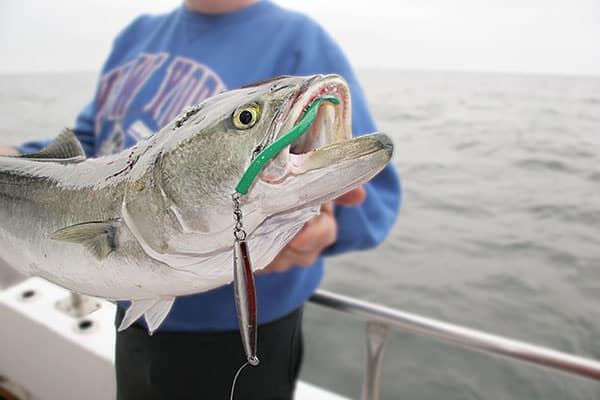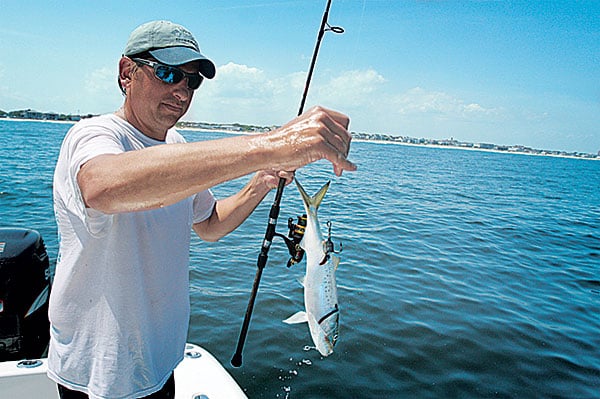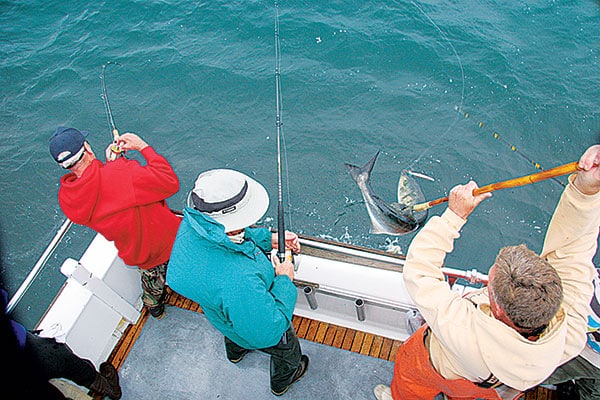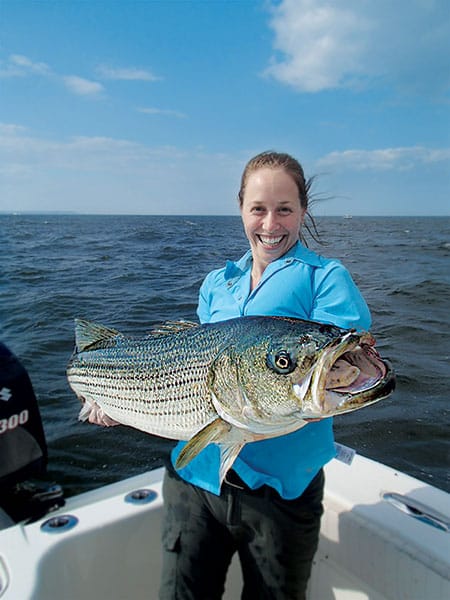Late spring along the Jersey coast is not a good time to be a bunker. As the oily baitfish school by the millions, the law of the land erupts, with predatory striped bass and bluefish knocking the snot out of them on their migratory push northward. A double-barreled blast of bass and bluefish means smiles for the angler. And though trolling proves effective this time of year, there’s infinitely more fun in getting in the game with a trifecta of jigging, popping and live-lining. Prepare for slammer blues of 10 to 18 pounds and stripers that push the 50-pound mark.
Dance a Jig
Jigs draw some of the most punishing hits in any saltwater arena, as the fluttering, wobbly motion incites animosity in predatory fish. If bunker schools are marking thick, then snag-and-drop techniques seem to outfish artificials, but when the schools of bass and blues are marking without a solid presence of bait, then break out the jigs and spoons. Capt. Bob Bogan of Gambler relies on 3- to 5-ounce Krocodile spoons in white or silver, Ava A27 to A67 jigs, and 2- to 4-ounce Deadly Dick metals to put fish on deck. Perfected presentation determines success.
“With Kroc jigs, you want a sexy wobble to it,” he says. Before you even start jigging, cast and retrieve to figure out the pace that makes the spoon flutter — not too fast and not too slow. Then you have the spoon calibrated for the drop.” Bogan’s preferred jigging spoon method calls for casting up-drift of the current, letting the spoon hit bottom, then cranking it back to the surface at that calibrated pace. “When you’re almost up to the top, it’s important to maintain the pace: Do not simply reel up the last 5 feet impatiently to recast. I can’t tell you how many times bass or blues follow the spoon all the way to the boat and hit when it’s 2 to 3 feet under the surface. Finish your retrieve every time.”
If you find yourself on the windward side of the boat, reel in a bit slower because the drift adds friction on the spoon, and you won’t have to reel as quickly to get the desired wobble action. “While drifting away from the boat as it sinks, the spoon will almost be trolled at an angle to the boat, which isn’t a bad thing,” says Bogan. “Bass and blues will follow it as it moves at an angle through the water.” Unlike spoons, thinner-profile metals like the Deadly Dick or Ava jig can be bounced off the bottom to be more effective, hitting the seafloor, and then swung up 3 to 5 feet and dropped back down. “Work the lower water column with the thin metals, hopping them off the seafloor, but don’t be afraid to reel them up to the top at a moderate pace as well for a strike,” says Bogan.
Snag-and-Drop
Locals know it isn’t rocket science, but you increase your catch ratio considerably with the snag-and-drop on bunker schools. Bunker snags are weighted death, a treble hook loaded with lead and flung into a school of bunker, ripped through until you hit a mark, then free-spooled and dropped back to feeding fish. The theory is simple, but the technique involves some strategy. Bluefish ravage the bunker schools above, below, and through the school, slicing and dicing them by the dozens, leaving a pretty grotesque scene of half-live bunker spinning in circles as they twitch to the seafloor, and that’s where the cow bass await to pick up the scraps.
Bluefish actually propagate the striper feeding frenzy, creating a natural chum slick and free food shower from above. Bass remain below, inhaling the falling chunks of bunker, picking off an easy meal with little effort. Injured bunker baits actually work better than fresh and lively bunker, so if a bluefish cuts off the back end or takes a chunk out of a hooked bait, simply let it fall below the bait school down to bass awaiting the easy pickins’. Most anglers bring in a treble-snagged bunker and rehook it on a size 10/0 circle hook, through the back behind the dorsal fin if the drift is slow, or through the lips for a quicker drift, on a sliding fish-finder rig. The circle hook allows for a surefire hook-set and an easy release on the fish. Bluefish strikes are herky-jerky, and the hook should be set quickly, but bass tend to play around with the bunker first, then run off at a steady pace. If you think it’s a bass on the other end, give it a five-count, and then engage the circle hook.
Surface Strikes
When the waters boil and erupt, and fish feed aggressively with tunnel vision, topwater poppers garner jaw-dropping strikes from 40-pound-caliber bass. “I don’t think there’s anything more exciting than a reaction strike on a surface popper,” says striper guide Rich Swisstack. He breaks out the poppers for three occasions: 1) to bring fish up to the surface that might be hanging deep; 2) when bunker schools are both thick or thin; and 3) when fishing around jetties. “It’s fairly easy to find fish when the birds are diving on the bait schools, but when it starts to get quiet around 11 a.m., and the fish move from 30 feet out to 55 to 65 feet, they need a little cajoling. We’ll mark fish hanging in scattered packs, then work a surface popper to create noise, which triggers both bass and blues to come up to see what’s going on.”
Once one fish becomes entranced with the commotion, more usually follow it to the surface. The preferred method to truly make the popper dance is a sluggish walk-the-dog style. Whip the rod side to side to sploosh water and mimic the tail-slap of a bunker. “Turn the handle just enough to take the slack out of the line, and pull the rod sideways to work the popper, not up and down,” says Swisstack. That flailing method is deadly when bunker schools are thin, or when fishing off jetty tips. “Stay a good cast-and-a-half off the jetty, and place that popper right off the tip, working it back slowly. There are usually plenty of submerged rocks a good 20 yards off that tip where bass hide, waiting to ambush anything on the surface.” When bass and blues are aggressively and recklessly pounding the bunker schools, poppers pull them off the school and into a savage reaction strike. “Cast the popper to the outskirts of a nervous bunker school, and watch the bass and blues fight over who’s going to pounce on it first,” he says.
When the bunker schools are thick, don’t limit your game plan to a morning shift. Plan an entire day from sunup to sundown patrolling the Jersey coast to hopscotch the bunker schools, and use the three-pronged approach — jigging, live-lining and popping — to push your adrenaline meter to the max!














